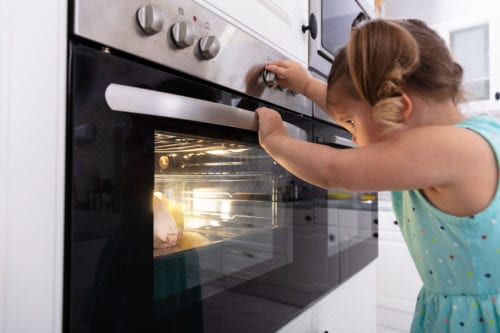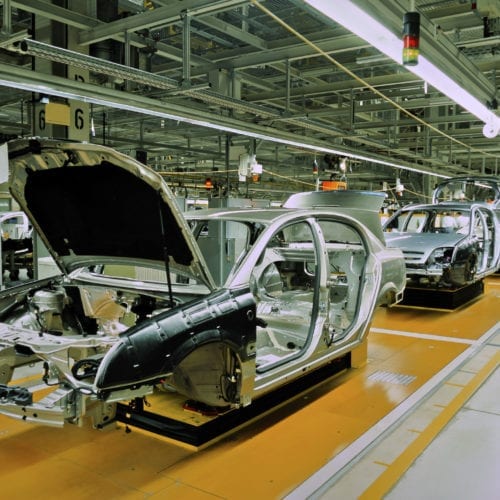
We Are Living in a Materials World
It’s as true today as it was when Madonna first sang it more than three decades ago: we are living in a material(s) world. Besides cluttering our lives, the objects around us are produced via a multistage process called a supply chain. The sleek stove in your kitchen—which is electric, of course, because you’re environmentally conscious—is a mishmash of steel, copper, plastics, and a bunch of other materials. And what about the building you live in, the bridge you cross each morning on your way to work, the pavement on the road, and pretty much everything machine-made that you can think of? Each of these final products contains materials that have been extracted (or sometimes recycled), processed, and transported across thousands of miles. And, end goods are often made of intermediary products, meaning that each production tier involves a factory and some transport, too.
This represents both a testament to the sophistication of human ingenuity and a large environmental footprint, one that comes mainly in the form of greenhouse gases. Consider this: in 2017, the most recent year for which metrics are available, the global economy emitted 53.5 gigatons of CO2 equivalent. Of these, 21.9 gigatons, over 40 percent of the global total, were emitted in industrial supply chains, which include things like mining, cement, steel, and heavy transport.
The journey ends right at your doorstep in the form of final goods, construction materials, and pretty much everything that isn’t from your garden (and even then, did you use fertilizer?). The problem is, the emissions embodied in products are practically invisible. Unless they come straight from the exhaust tube of your car, odds are you aren’t aware of them. How many kilograms of CO2 were emitted to produce the screen that you’re reading this article on? Any idea—even a ballpark figure? You can’t tell, and that’s a problem because there’s no way to choose lower-emission products—and no way to hold companies accountable for producing higher-emitting products.
Decreasing the Environmental Footprint of Our Materials
The Materials Initiative at Rocky Mountain Institute was started from exactly this paradigm. Our corporate clients, mostly large mining companies such as BHP, Anglo American, and Gold Fields, have embarked on a journey to reduce their emissions, and we have provided them with advice on how to do it. For example, we’ve helped these companies model renewable energy at their sites, innovate on-site hauling, and repurpose legacy assets to help reduce carbon emissions. We’ve also undertaken coalition-building efforts, such as the Energy and Mining Collaboration in Australia, together with government, academic, and industry players such as OZ Minerals; and we stay active in the research space via groundbreaking work such as the Australia Energy Transitions Initiative.
However, there is still a large gap between what companies are willing to do today and what needs to happen to keep global warming within 1.5°C by 2050. To meet this target, we need to reduce greenhouse gas emissions across the board by 45 percent in the next decade. Given the long cycle of capital investment in heavy industry, the only way to get there is, essentially, by slashing emissions in half with every new investment that is made, starting now. On top of that, we would also need to retrofit every existing production asset to the same carbon efficiency, from mines to processing facilities to the vehicles used to move goods across the global economy.
But how do we get there? Despite renewable energy technology having taken giant steps—solar is 65 percent cheaper than it was 10 years ago—current market dynamics don’t provide enough incentives for the transition to happen at the speed required. This is why we decided to expand into a new area. While RMI continues to provide technology solutions to those who need them and to lead the charge on adapting low-carbon innovation to industrial settings, RMI’s Materials Initiative has started thinking about levers that can incentivize industrial sectors to move faster.
At a high level, there are three levers: First, governments can introduce regulation to drive emitters out of the market—for example, by pricing carbon or outlawing certain modes of energy supply. Second, consumers can demand goods with a lower environmental footprint. And third, those who provide the lifeline to industrial companies—that is, their investors—can start making investments in greener companies. The work that we’ve performed in the policy advocacy realm has so far been limited to promoting the use of brownfields for renewable energy, via a partnership with The Nature Conservancy and The Wilderness Society. We’ve now decided that we need to tackle the market-driven demand levers: how can mechanisms be enabled?
The Importance of Carbon Transparency
Let’s go back to the example of your electric stove. There were many different models on display, and you picked the one that offered the best price–performance ratio. What was that performance all about? It was the technical specs: the fact that it was all electric, the capacity of the oven, its functionalities, and so forth. Imagine if among those performance drivers there had been a metric about the footprint of the production process. Would you have discriminated between the stove that had been made with 300 kg of CO2 equivalent and the stove that took 2 tons of CO2 to produce? The odds are, as a reader of this blog, you might have.
But there was no such choice. This is because, to date, there is no universally accepted system to ensure the transparency of emissions or allow for comparison across materials and products. Besides not giving you a choice as a consumer, this deprives manufacturers of a choice to fulfill their own decarbonization targets. Manufacturers are an important aggregator of consumer preference, and they can exert significant pressure on the supply chain to provide low-carbon materials, ideally at no premium.
This is why the Materials Initiative is promoting carbon transparency as a key enabler of low-carbon commodities. Together with the MIT Sustainable Supply Chains initiative, Columbia Center for Sustainable Investment, and Colorado School of Mines, we are building the Coalition On Materials Emissions Transparency (COMET) to form a collaboration among heavy industrials, manufacturers, and investors around the idea that emissions transparency will be the key enabler of green commodity market mechanisms. We’re already working on green steel, and we’re also working to promote the idea that a standard methodology “based on the GHG Protocol” is needed for the key materials industries, similar to the GLEC framework for logistics and the ICT Sector Guidance. Such a standard will then enable us to work with all actors involved to create green commodity markets.
Reducing Financial Climate Risk
In recent years, the financial community has started to become conscious about the footprint of these investments, which represent a risk category of increasing relevance: climate risk. But how can financiers make efforts to reduce climate risk, and how can they compare the activities of companies that produce different things? Together with RMI’s Global Climate Finance program, we’re exploring ways that the successful experience of the Poseidon Principles for the shipping sector might be reproduced in heavy industries such as steel, cement, and metals.
Finally, we haven’t forgotten what Madonna’s Material Girl does when boys don’t give her proper credit: she walks away. We know that we need to stay close to heavy industry and keep providing advisory services to drive technology adoption once the market signals are in place. For example, we’re working to integrate the insights from our global experience with microgrids into an application that will automate part of the modeling process. We also listen to the industry’s concerns with social license to operate, especially in mining, where this is currently the top risk item. And we’ve created a collaboration with the Development Partner Institute to work on the nexus between energy and community engagement. We don’t think heavy industry is, or should be, disappearing or shrinking; still, we owe it to our planet, to our children, and to ourselves to produce commodities in a way that is aligned with the 1.5-degree pathway that is required to make sure we keep living in a materials world—but also on a habitable planet.
If you’re interested in knowing more about our work, please get in touch at outreach@rmi.org.


